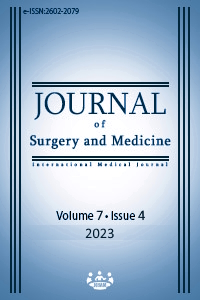Immunohistochemical study of CD147 and matrix metalloproteases in meningiomas
CD147 and matrix metalloproteases in meningiomas
Keywords:
Meningioma, Immunohistochemistry, E-Cadherin, Galectin-3, CD147, MMP9, MMP2, Matrix MetalloproteasesAbstract
Background/Aim: Expression of extracellular matrix proteins and metalloproteases (MMPs) has been implicated in neoplasm recurrence. Some recent studies have suggested a correlation between matrix modifier proteins and recurrence or invasion of meningiomas. Based on previous data, the aim of this study was to find a correlation between the immunohistochemical (IHC) expression patterns of a group of matrix modifier proteins, including CD147, Matrix Metalloprotease 2 and 9 (MMP2 and 9, respectively), Epithelial Cadherin (ECAD), and Galectin-3 (GAL3) with World Health Organization (WHO)-defined grade, brain invasion, recurrence, and other clinicopathological features.
Methods: This study was a cohort study. All patients with meningioma who underwent resection over a 10-year period were identified from the electronic pathology archives. Tissue microarrays (TMAs) were created for IHC studies, and IHC staining was performed using standard methodology.
Results: A total of 231 cases fulfilled the study criteria. Histological review identified 198 grade 1 tumors (85.3%), 28 grade 2 tumors (12.6%), and five grade 3 tumors (2.2%). CD147 was determined to be positively correlated with WHO-defined grade (P=0.009). ECAD, MMP2, MMP9, GAL3 were not found to be correlated with brain invasion, recurrence, or WHO grade.
Conclusion: The study results demonstrated that CD147 could be a target for diagnosis, prognosis, and treatment of meningiomas.
Downloads
References
Louis DN. Meningiomas. In: Louis DN, Ohgaki H, Wiestler OD, Cavenee WK, Ellison DW, Figarella-Branger D, Perry A, Reifenberger G, von Deimling A, eds. WHO Classification of Tumours of the Central Nervous System. 4th ed. Lyon, France: International Agency for Research on Cancer (IARC); 2016. pp. 285-297.
Perry A, Stafford SL, Scheithauer BW, Suman VJ, Lohse CM. Meningioma grading: an analysis of histologic parameters. Am J Surg Pathol. 1997;21(12):1455-65. PMID: 9414189. DOI: https://doi.org/10.1097/00000478-199712000-00008
Perry A, Scheithauer BW, Stafford SL, Lohse CM, Wollan PC. "Malignancy" in meningiomas: a clinicopathologic study of 116 patients, with grading implications. Cancer. 1999; 85(9):2046-56. PMID: 10223247. DOI: https://doi.org/10.1002/(SICI)1097-0142(19990501)85:9%3C2046::AID-CNCR23%3E3.0.CO;2-M
Bernstein LR, Liotta LA. Molecular mediators of interactions with extracellular matrix components in metastasis and angiogenesis. Current opinion in oncology. 1994;6(1):106-13. PMID: 7515692. DOI: https://doi.org/10.1097/00001622-199401000-00015
Frantz C, Stewart KM, Weaver VM. The extracellular matrix at a glance. Journal of cell science. 2010;123(24):4195-200. doi: 10.1242/jcs.023820. DOI: https://doi.org/10.1242/jcs.023820
Caffo M, Caruso G, Galatioto S, Meli F, Cacciola F, Germano A, et al. Immunohistochemical study of the extracellular matrix proteins laminin, fibronectin and type IV collagen in secretory meningiomas. J Clin Neurosci. 2008;15(7):806-11. doi: 10.1016/j.jocn.2007.05.029. DOI: https://doi.org/10.1016/j.jocn.2007.05.029
Park SH, Min HS, Kim B, Myung J, Paek SH. Galectin-3: a useful biomarker for differential diagnosis of brain tumors. Neuropathology. 2008;28(5):497-506. doi: 10.1111/j.1440-1789.2008.00909. DOI: https://doi.org/10.1111/j.1440-1789.2008.00909.x
Hancq S, Salmon I, Brotchi J, Gabius HJ, Heizmann CW, Kiss R, Decaestecker C. Detection of S100B, S100A6 and galectin-3 ligands in meningiomas as markers of aggressiveness. International journal of oncology. 2004;25(5):1233-40. PMID: 15492810. DOI: https://doi.org/10.3892/ijo.25.5.1233
Gao H, Lan X, Li S, Xue Y. Relationships of MMP-9, E-cadherin, and VEGF expression with clinicopathological features and response to chemosensitivity in gastric cancer. Tumour Biology. 2017; 39(5):1010428317698368. doi: 10.1177/1010428317698368. DOI: https://doi.org/10.1177/1010428317698368
Utsuki S, Oka H, Sato Y, Kawano N, Tsuchiya B, Kobayashi I, Fujii K. Invasive meningioma is associated with a low expression of E-cadherin and beta-catenin. Clin Neuropathol. 2005;24(1):8-12. PMID: 15696778.
Zhou K, Wang G, Wang Y, Jin H, Yang S, Liu C. The potential involvement of E-cadherin and beta-catenins in meningioma. PloS One. 2010;5(6):e11231. PMID: 20574529. DOI: https://doi.org/10.1371/journal.pone.0011231
MacDougall JR, Matrisian LM. Contributions of tumor and stromal matrix metalloproteinases to tumor progression, invasion and metastasis. Cancer metastasis reviews. 1995;14(4):351-62. PMID: 8821095. DOI: https://doi.org/10.1007/BF00690603
Roy R, Yang J, Moses MA. Matrix metalloproteinases as novel biomarkers and potential therapeutic targets in human cancer. J Clin Oncol. 2009;27(31):5287-97. PMID: 19738110. DOI: https://doi.org/10.1200/JCO.2009.23.5556
Jaalinoja J, Herva R, Korpela M, Hoyhtya M, Turpeenniemi-Hujanen T. Matrix metalloproteinase 2 (MMP-2) immunoreactive protein is associated with poor grade and survival in brain neoplasms. J Neurooncol. 2000;46(1):81-90. PMID: 10896208. DOI: https://doi.org/10.1023/A:1006421112839
Shuman Moss LA, Jensen-Taubman S, Stetler-Stevenson WG. Matrix metalloproteinases: changing roles in tumor progression and metastasis. Am J Pathol. 2012;181(6):1895-9. PMID: 23063657. DOI: https://doi.org/10.1016/j.ajpath.2012.08.044
Sameshima T, Nabeshima K, Toole BP, Yokogami K, Okada Y, Goya T, et al. Expression of EMMPRIN (CD147) a cell surface inducer of matrix metalloproteinases, in normal human brain and gliomas. Int J Cancer. 2000;88(1):21-7. PMID: 10962435. DOI: https://doi.org/10.1002/1097-0215(20001001)88:1<21::AID-IJC4>3.0.CO;2-S
Riethdorf S, Reimers N, Assmann V, Kornfeld JW, Terracciano L, Sauter G, et al. High incidence of EMMPRIN expression in human tumors. Int J Cancer. 2006;119(8):1800-10. PMID: 16721788. DOI: https://doi.org/10.1002/ijc.22062
Kanekura T, Chen X, Kanzaki T. Basigin (CD147) is expressed on melanoma cells and induces tumor cell invasion by stimulating production of matrix metalloproteinases by fibroblasts. Int J Cancer. 2002;99(4):520-8. PMID: 11992541. DOI: https://doi.org/10.1002/ijc.10390
Hsiang-chi Tseng, Wei Xiong, Saiaditya Badeti, Yan Yang, Minh Ma, Ting Liu, et al. Efficacy of anti-CD147 chimeric antigen receptors targeting hepatocellular carcinoma. Nature Communications. 2020;11(1):4810. doi: 10.1038/s41467-020-18444-2. DOI: https://doi.org/10.1038/s41467-020-18444-2
Hui Li, Zhouhuan Xi, Xuejiao Dai, Wenyue Wu, Yanwen Li, Yanting Liu, et al. CD147 and glioma: a meta-analysis. J Neurooncol. 2017;134:145–56. DOI: https://doi.org/10.1007/s11060-017-2499-4
Peng J, Jiang H, Guo J, Huang J, Yuan Q, Xie J, et al. CD147 Expression Is Associated with Tumor Proliferation in Bladder Cancer via GSDMD. Bio Med Research International. 2020;2020:7638975. PMID: 32149134. DOI: https://doi.org/10.1155/2020/7638975
Tsai WC, Chen Y, Huang LC, Lee HS, Ma HI, Huang SM, et al. EMMPRIN expression positively correlates with WHO grades of astrocytomas and meningiomas. J Neurooncol. 2013;114(3):281-90. PMID: 23817808. DOI: https://doi.org/10.1007/s11060-013-1184-5
Chen Y, Jing Xu, Wu X, Yao H, Yan Z, Guo T, et al. CD147 regulates antitumor CD8+ T-cell responses to facilitate tumor-immune escape. Cell Mol Immunol. 2021;18(8):1995-2009. doi: 10.1038/s41423-020-00570. DOI: https://doi.org/10.1038/s41423-020-00570-y
Downloads
- 336 606
Published
Issue
Section
How to Cite
License
Copyright (c) 2023 İlkay Çinar, Filiz Karagöz
This work is licensed under a Creative Commons Attribution-NonCommercial-NoDerivatives 4.0 International License.
















